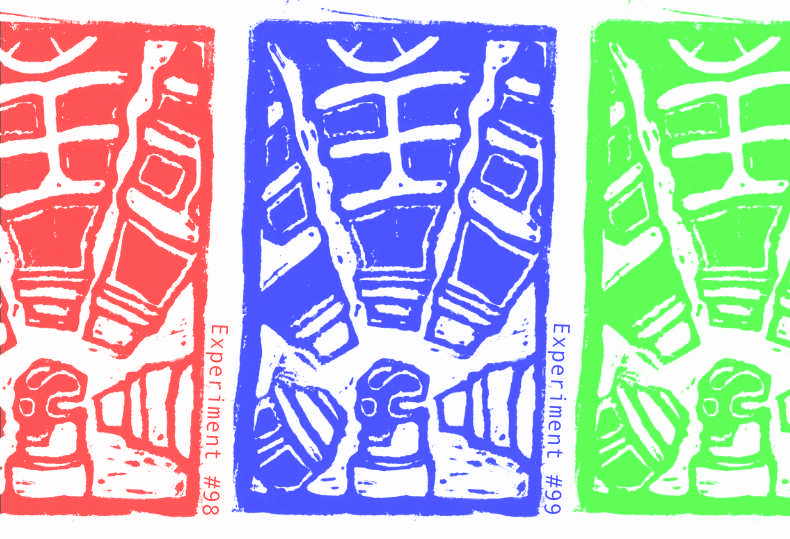New breakthrough in spectral imaging: 3D analysis of photosensitive materials using a digital twin

They studied the conditions for minimising the dose of X-rays applied to a sample during analysis. By creating a digital twin of the experiment, they were able to explore a wide range of experimental parameters. Their study, published in the journal Science Advances, shows that it is possible to reduce the dose used by a factor of ten while retaining the ability to determine the stratigraphy of a paint sample, based on the optimal values identified by the algorithm.
This approach now allows the analysis of highly photosensitive samples using methods previously considered too aggressive for these materials.
Spectral imaging
In photonic analysis, a spectrum is obtained by sending a beam onto a sample, varying a parameter, often the incident (or re-emitted) energy, and collecting the response on a detector. By collecting the signal pixel by pixel, a spectral image is generated. This image is referred to as hyperspectral when the energy range is continuous, and multispectral when it is discrete.
Spectral imaging using photon excitation in the X-ray, UV or visible range is widely used to identify chemical compounds and classify pixels according to their composition, but also to spatially classify material for various fields of application: satellite remote sensing, forest management, plant biology, food and heritage chemistry.
However, many imaging modalities involve high doses of radiation, which can lead to irreversible damage to samples.
Preserving sample integrity and analysing photosensitive materials
Advanced spectral imaging techniques face an inherent trade-off between signal intensity and sample integrity.
In chemical imaging, the large amount of information collected with hyperspectral and multispectral imaging involves a high dose of electromagnetic radiation, which is necessary to collect a sufficient signal but can irreversibly damage inorganic samples and, even more so, organic samples. Various approaches are used to obtain sufficient count statistics while mitigating damage, such as cryogenic freezing. However, cold temperatures can themselves be very detrimental to sample integrity.
Furthermore, strategies based on increasing beam size, reducing beam flux and/or acquisition time have a significant impact on the data collected. Reducing the dose can pose the challenge of disentangling the collected signal. A critical choice must therefore be made to find a compromise between sample preservation and the amount of knowledge collected.
Traditionally, the optimisation of acquisition parameters, such as source wavelength, intensity and exposure time, has been based on empirical adjustments aimed at improving image contrast.
X-ray Raman spectral imaging
Researchers have identified a particularly promising method: X-ray Raman scattering. This technique, which requires a large instrument (synchrotron), has the unique ability to probe light elements in 3D (carbon, oxygen, nitrogen, etc.). However, it requires extremely high doses of radiation, making it impossible to analyse photosensitive materials.
The creation of a ‘digital twin’ paves the way for 3D analysis of photosensitive materials
To overcome this obstacle, they developed a ‘digital twin’ of an imaging experiment — i.e. a virtual model of the experiment, combining experimental and ‘synthetic’ data, which can be used to simulate the result obtained by digitally varying the parameters of the experiment.
They demonstrated that the development of a suitable ‘digital twin’ enables the imaging of radiosensitive organic samples. They tested a large number of experimental configurations and identified those that led to better classification of chemical species.
Its use made it possible to reduce the acquisition time tenfold while maintaining operation below the damage threshold, paving the way for high-definition spectral imaging with minimal degradation of sensitive organic samples.
By fixing the dose received by the sample, they determined the experimental conditions that would allow data to be collected on a particularly photosensitive paint sample.
The hybridisation of the real world of the experiment and the synthetic world of the digital twin has enabled 3D speciation of photosensitive materials and paves the way for faster and more efficient imaging modalities, preserving samples from biology to chemistry and materials science.
Interdisciplinary and multi-institutional work
The international team consists of:
- Laure CAZALS, Lauren DALECKY and Loïc BERTRAND: laboratoire de chimie, "Photophysique et Photochimie Supramoléculaires et Macromoléculaires" (PPSM - ENS Paris-Saclay, CNRS, Université Paris-Saclay),
- Agnès DESOLNEUX: laboratoire de mathématiques, le Centre Borelli (ENS Paris-Saclay, CNRS, Université Paris-Saclay)
- Simo HUOTARI: Department of Physics of University d'Helsinki
- Christoph SAHLE and Alessandro MIRONE: synchrotron européen ESRF
- Serge Cohen: laboratoire IPANEMA (CNRS, UVSQ, MNHN, Department of Culture)
This work was initiated by an unprecedented collaboration between the chemistry and mathematics departments of ENS Paris-Saclay, and benefited from a Long Term Project at the European synchrotron ESRF (HG-171). It was funded by the European Commission as part of the GoGreen project (GA no. 101060768).
